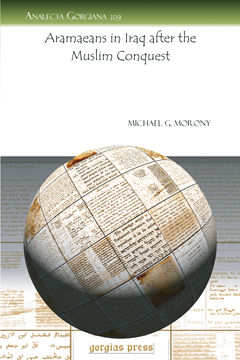Michael G. Morony
Iraq After The Muslim Conquest
Series: Perspectives on Society and Culture 3
ISBN: 978-1-59333-315-7
Morony compares conditions in late Sasanian and early Islamic Iraq in the seventh century AD and depicts both the emergence of a local form of Islamic society, and the interaction of Muslim conquerors from Arabia with the native population.
$261.00 (USD) $156.60 (USD)
Christians in Iraq after the Muslim Conquest
Series: Analecta Gorgiana 111
ISBN: 978-1-59333-602-8
This brief introduction to the state of Christianity in Iraq during the ascendancy of Islam begins with a discussion of the friction between Christians and Magians. The political role of the church among the Sassanians, both internally and externally, is addressed. With the Islamic conquest various traditions circulated regarding the tolerance of Christianity within Muslim jurisdiction. Morony skillfully navigates these traditions, providing a plausible historical view. The formation of the Assyrian Church of the East’s doctrine and identity as well as their schools, monasteries, laws, and their sense of community and separateness are considered. The contrast with Monophysites with their “Nestorian” competitors rounds out the discussion.
$42.00 (USD) $25.20 (USD)
Aramaeans in Iraq after the Muslim Conquest
Series: Analecta Gorgiana 109
ISBN: 978-1-59333-600-4
This extract from Michael G. Morony’s Iraq After The Muslim Conquest presents a brief yet through presentation of the complex language and political history of the Aramaeans of that region. The interaction of the Aramaeans and the Arabs during the period of the Islamic conquest is sketched out, citing the important families and individuals that stand out in this situation. The somewhat uneasy mutual relationship between the Arabs and Aramaeans is briefly explored.
$32.00 (USD) $19.20 (USD)
Jews in Iraq after the Muslim Conquest
Series: Analecta Gorgiana 110
ISBN: 978-1-59333-601-1
As the oldest organized religion in Sassanian Iraq, Judaism serves as a kind of model for other religious organizations in the region. After considering the growth of Judaism in Iraq during the Sassanian period, Morony notes the connections between the Jewish and Aramaean populations as well as the intermixed ethnic communities in which Jews played a part. Social, administrative, and religious issues are all considered. Messianic expectations as they continued to develop in the Jewish community in diaspora round out this discussion of Judaism as a fully developed religion in Iraq under Islamic rule.
$36.00 (USD) $21.60 (USD)
Iraq After The Muslim Conquest
ISBN: 1-59333-315-3
Morony compares conditions in late Sasanian and early Islamic Iraq in the seventh century AD and depicts both the emergence of a local form of Islamic society, and the interaction of Muslim conquerors from Arabia with the native population.
$262.00 (USD) $157.20 (USD)





